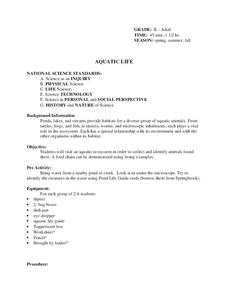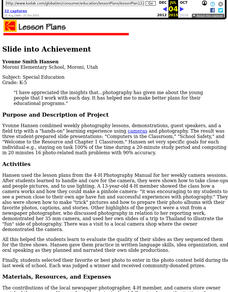Curated OER
New Year Celebrations in Japan
Students are introduced to the way the Japanese celebrate the new year. Using the internet, they compare and contrast the celebrations in Japan with those in Korea. After being read a story, they complete a worksheet on the series of...
Curated OER
Properties of Matter
Second graders investigate how objects can be described, classified and compared by their composition. They recognize that the same material can exist in different states. Students verify that things can be done to materials to change...
Curated OER
Butterfly Round-Up
Students classify the characteristics of butterflies and moths moths. In this life cycle lesson, students identify butterflies and moths common in the state of Iowa as well as their characteristics. Students then learn the proper...
Curated OER
The Environment
Learners participate in three stations in which they are made aware of the environment, ways to preserve it, the importance of preserving it and their part in preserving it. They discuss where items are found, recycling, and...
Curated OER
Aquatic Life
Learners explore aquatic life. In this science lesson, students visit an aquatic ecosystem and collect animals found there. Learners create a food chain for the aquatic ecosystem.
Curated OER
Animal Coverings
Young scholars compare and contrast the types of coverings found on animals. They identify a wide variety of animals in a museum room. They classify animals based on their coverings as well.
Curated OER
Kids' Bread Restaurant
Students use technology as a tool for learning. They work together on a special project.
Curated OER
In the Company of Wild Butterflies
Students discover the life cycle of a butterfly and explain the different stages. In this exploratory lesson students watch a video and create insect art and they will get an opportunity to view live specimens of butterflies.
Curated OER
Truly Amazing Mammals
Explore the world of amazing mammals with your kids with special needs. Each child identifies one mammal from a previous lesson and writes a short paragraph on that mammal. This lesson states that it is intended for all levels, but not...
Curated OER
A Teeth Changing Experience
Students research human health by reading an educational story in class. In this oral health instructional activity, students identify the importance of brushing their teeth and consuming calcium. Students read the book A Teeth...
Curated OER
Build a Black History Database/Timeline
Students research famous people and events in Black History then break the biographies and events down into specific information related to dates in history. They
Curated OER
How Does a Butterfly Grow?
Students explore the stages of a butterfly. They read and discuss the book, The Very Hungry Caterpillar, by Eric Carle. They draw a picture of their favorite part and create a graph. They write a letter to Eric Carle and observe a...
Curated OER
The Amazing Maud Lewis
Students investigate cultural art from Canada by reading about Maud Lewis. In this Canadian history lesson, students identify the work of Lewis by visiting her magazine website. Students identify other heroes in Nova Scotia...
Curated OER
Music in Japan - Fine Arts
Second graders discuss various types of music. They identify and explore Japanese music, and instruments. They make a koto.
Curated OER
Bird Stories: Fact or Fiction
Students evaluate/distinguish scientific fact from fiction. They discuss similarities and differences in the life cycles of various birds. Student use the Internet as a research tool.
Curated OER
North Carolina State Vegetable -- Day 2
Learners are introduced to the state vegetable of North Carolina, the sweet potato. In groups, they create their own sweet potato person using the items from a Mr. Potato Head. They write a summary of their person and a narrative about...
Curated OER
From Polliwog to Frog
Pupils examine how frogs change. In this life cycle lesson, students create a model to show how a frog changes throughout its life. Pupils will show the process of frog metamorphosis, from polliwog to adult frog.
Curated OER
What is a Fossil?
Students determine what a fossil is and distinguish between body fossils and trace fossils. They examine pictures of fossils and determine which represents a trace or body fossil.
Curated OER
Plants
Second graders examine the characteristics of plants. As a class, they brainstorm a list of items plants need in order to survive. In groups, they complete various experiments in which they discover the functions of the parts of the plant.
Curated OER
Slide into Achievement
Young scholars take close-ups and people pictures, and to use lighting. They evaluate the quality of their slides as they sequenced them for the three shows.
Curated OER
Animal Riddles
Students write animal riddles. They write three or more sentences describing a selected animal, and draw a picture to go with their descriptive sentences. Students then create a three slide slideshow using Kid Pix 3 computer software.
Curated OER
Measure Your Body
Young scholars measure their bodies. For this math lesson, students record their height and weight. Young scholars measure themselves in six months and observe any changes.
Curated OER
Finding the Friendship Dolls, A True Story: How Children Can Create World Peace
Students listen to the book Finding the Friendship Dolls, A True Story: How Children Can Help Create World Peace through Toys. In this world peace lesson, students choose events in the story to create a timeline of those events. Students...
Curated OER
Where is Flat Stanley?
Students create a story map of the basic elements and significant events of the book Flat Stanley. Students brainstorm places they would like to visit if they had been flattened and then, write about an imagined experience. Students...

























